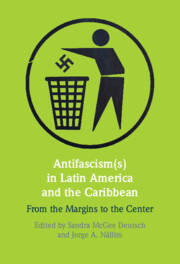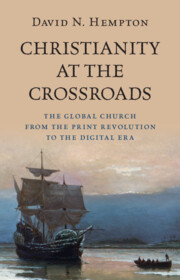Refine search
Actions for selected content:
386 results
3 - From Pattern to Constructions
-
- Book:
- Pattern, Construction, System
- Published online:
- 21 August 2025
- Print publication:
- 04 September 2025, pp 25-56
-
- Chapter
-
- You have access
- Open access
- HTML
- Export citation
An exploration of the impacts of Covid-19 on the work of conservation actors in Trinidad and Tobago
-
- Journal:
- Oryx , First View
- Published online by Cambridge University Press:
- 27 August 2025, pp. 1-8
-
- Article
-
- You have access
- Open access
- HTML
- Export citation
Decomposing Network Influence: Social Influence Regression
-
- Journal:
- Political Analysis , First View
- Published online by Cambridge University Press:
- 27 August 2025, pp. 1-20
-
- Article
-
- You have access
- Open access
- HTML
- Export citation
Introduction
-
-
- Book:
- María Irene Fornés In Context
- Print publication:
- 07 August 2025, pp xxix-xxxviii
-
- Chapter
- Export citation
Chapter 7 - Local Contexts and Transnational Influences
-
-
- Book:
- Antifascism(s) in Latin America and the Caribbean
- Published online:
- 21 July 2025
- Print publication:
- 07 August 2025, pp 143-163
-
- Chapter
- Export citation
2 - Religious Networks in the Reformation Era
-
- Book:
- Christianity at the Crossroads
- Published online:
- 19 May 2025
- Print publication:
- 31 July 2025, pp 45-75
-
- Chapter
- Export citation
1 - Towards a Theory of Transnational Religious Change
-
- Book:
- Christianity at the Crossroads
- Published online:
- 19 May 2025
- Print publication:
- 31 July 2025, pp 13-44
-
- Chapter
- Export citation
5 - Women’s Networks
-
- Book:
- Christianity at the Crossroads
- Published online:
- 19 May 2025
- Print publication:
- 31 July 2025, pp 146-178
-
- Chapter
- Export citation
6 - “Only Connect!”
-
- Book:
- Christianity at the Crossroads
- Published online:
- 19 May 2025
- Print publication:
- 31 July 2025, pp 179-208
-
- Chapter
- Export citation
3 - Religious Networks in the Age of Empire in New Spain and Africa
-
- Book:
- Christianity at the Crossroads
- Published online:
- 19 May 2025
- Print publication:
- 31 July 2025, pp 76-107
-
- Chapter
- Export citation
Introduction
-
- Book:
- Christianity at the Crossroads
- Published online:
- 19 May 2025
- Print publication:
- 31 July 2025, pp 1-12
-
- Chapter
- Export citation
Conclusion
-
- Book:
- Christianity at the Crossroads
- Published online:
- 19 May 2025
- Print publication:
- 31 July 2025, pp 209-220
-
- Chapter
- Export citation

Antifascism(s) in Latin America and the Caribbean
- From the Margins to the Center
-
- Published online:
- 21 July 2025
- Print publication:
- 07 August 2025
27 - Help and Rescue in Eastern Europe: The Case of Poland
-
-
- Book:
- The Cambridge History of the Holocaust
- Published online:
- 16 May 2025
- Print publication:
- 12 June 2025, pp 448-462
-
- Chapter
- Export citation
8 - How Do Children Think About Groups?
- from Section II - Middle Childhood
-
- Book:
- Child Development
- Published online:
- 19 June 2025
- Print publication:
- 12 June 2025, pp 122-136
-
- Chapter
- Export citation
Chapter 13 - Translocality and Translocalism
- from Part II - Developments
-
-
- Book:
- Space and Literary Studies
- Published online:
- 07 May 2025
- Print publication:
- 22 May 2025, pp 216-233
-
- Chapter
- Export citation

Christianity at the Crossroads
- The Global Church from the Print Revolution to the Digital Era
-
- Published online:
- 19 May 2025
- Print publication:
- 31 July 2025
‘Lightness is not superficiality, but gliding over things from above, without boulders on your heart’: unconventional locations and informal approaches to the history of the Resistance
-
- Journal:
- Modern Italy / Volume 30 / Issue 2 / May 2025
- Published online by Cambridge University Press:
- 19 May 2025, pp. 238-246
- Print publication:
- May 2025
-
- Article
-
- You have access
- Open access
- HTML
- Export citation
Chapter 26 - Correspondence
- from Part III - Writings
-
-
- Book:
- Percy Shelley in Context
- Published online:
- 17 April 2025
- Print publication:
- 24 April 2025, pp 196-202
-
- Chapter
- Export citation
Automated extraction of discourse networks from large volumes of media data
- Part of
-
- Journal:
- Network Science / Volume 13 / 2025
- Published online by Cambridge University Press:
- 02 April 2025, e4
-
- Article
-
- You have access
- Open access
- HTML
- Export citation

